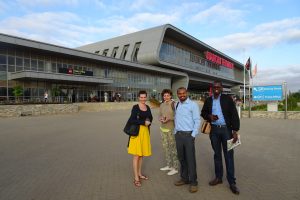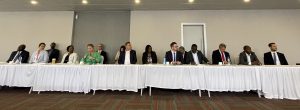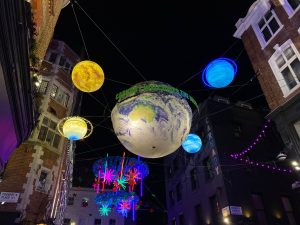HANS STOISSER
An experiment at the Learning Journey – What we can learn from China

Learning Journey to Silicon Savannah. 18 Europeans visited Nairobi in January. For four days we were exploring “Digital Africa”, “Urban Africa” and opportunities for “Co-Creation”. In this blogpost, I concentrate on Co-Creation and just one aspect, China in Africa.
Madaraka Express
Yes, also China is “co-creating” in Africa! And not only exploiting and colonizing, as we Europeans like to think.
Co-creation is a form of collaboration “that brings different parties together, in order to jointly produce a mutually valued outcome“.

China has financed and built the 472 km railway line between Kenya’s capital Nairobi and its second biggest city Mombasa. After a construction time of fewer than 5 years the so-called “Madaraka Express” was opened in May 2017.
Ever since signing the Memorandum of Understanding between the Kenyan government and the state-owned China Road and Bridge Corporation in 2011, the project has been heavily criticized by Europeans: too old technology, only diesel engines and only one track, too few trains, no train station in the city centre, too expensive.
Our experiment

Our team of the Learning Journey made an experiment. Early morning of day four we checked in at the Nairobi station of the Madaraka Express. More than one hour ahead of the scheduled departure time, we went through airport-like security and entered the train station’s main hall. On our way to the platform, we stepped through a cordon of nicely uniformed personnel. Twenty minutes prior to departure we had to take our assigned seats and departed at the exact minute. Each carriage had its own steward or stewardess, who made all the announcements informatively and politely.

We enjoyed travelling, but already after 20 minutes, we had to get off at Athi River station, on the outskirts of Nairobi. The experiment was over, our bus waited for the next program point of our Learning Journey.
Our impression: A well-organized and reliable train operation with excellent service. From easy online booking to a ride in comfortable coaches, also in 2nd class.
The travel time between Nairobi and Mombasa has halved and has become affordable for many Kenyans. With the new railway line, Kenya has put in place a big and very important new infrastructure. The first of its type for many decades.
What we can learn from China
Kenya and its Chinese partners opted for a BOT model: build-operate-transfer. For 5 years a Chinese company is still operating the railway line, and then it will be handed over to the Kenyan state.
Contrary to all that we think, Chinese companies did not come with all their personnel to build and operate. In our small experiment, we could see that all customer services are being delivered by Kenyans. On our journey, we actually got aware of only two Chinese people who worked in the background.
It seems that detailed and carefully planned structures have been put in place by the Chinese partners. Highly professional management is at work. The BOT structure has been used for co-creating a huge infrastructure project. Generally no easy task.
So, why are we – Europeans, Westerners – generally criticizing Chinese engagement in Africa so much? And do not see that investments like this railway line do deliver real customer value?
Because the Chinese state and Chinese companies work differently? Different quality, different ways of engaging and communicating, different financing, different propaganda, different transparency?
Yes, they do it differently. Also with much room for critique.
However – China builds and co-creates Africa’s infrastructure. Europe does not.



